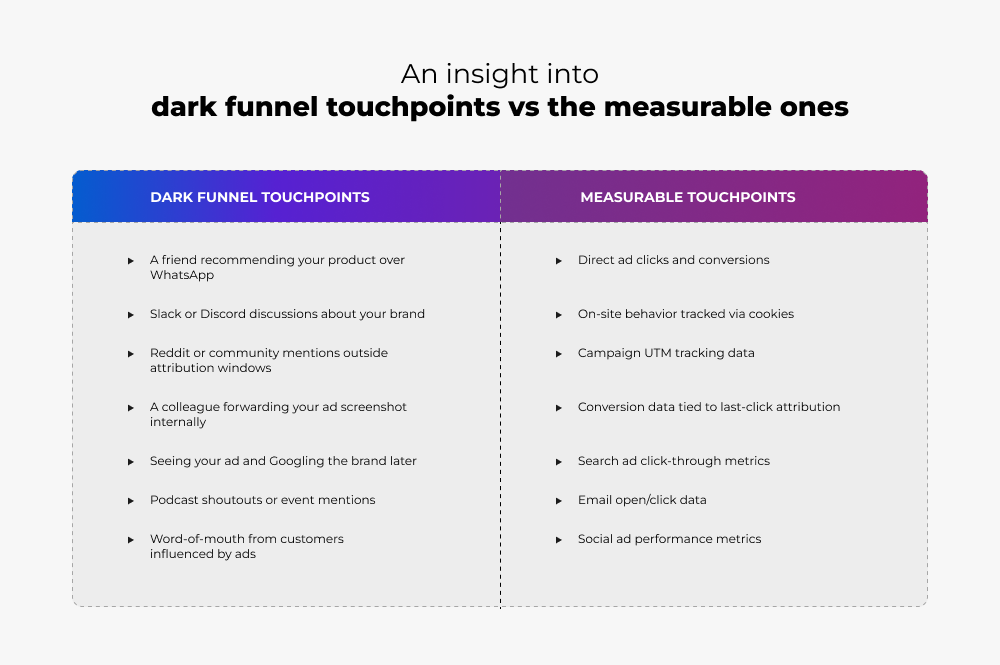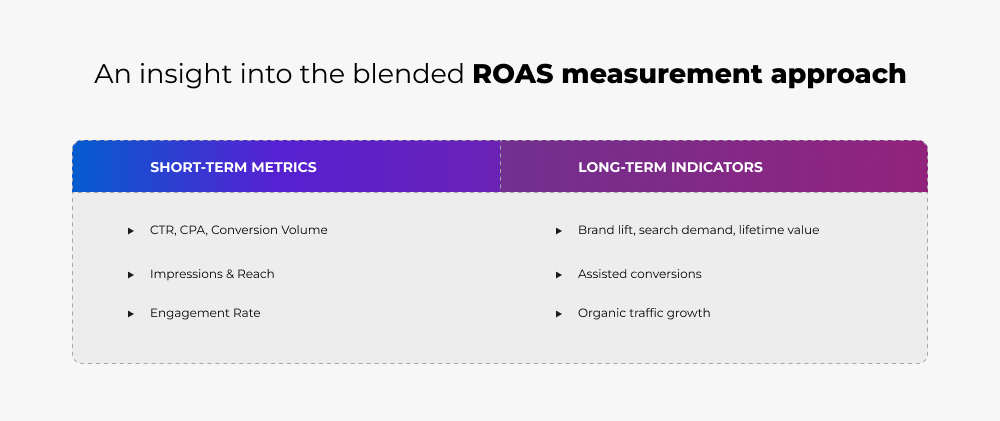Honestly, every paid search marketer has had that moment.
You’re looking at your dashboard, campaigns optimized, audiences refined, and creatives crisp. ROAS looks… okay, but something doesn’t add up.
Sales are up. Leads are flowing. Yet your attribution model is shrugging like, “Duh! Don’t look at me.”
So you start digging: Maybe tracking’s broken? Maybe GA4 is lagging again? Or maybe, just maybe… something bigger is happening.
That “something” has a name.
Welcome to the Dark Funnel, the messy, mysterious, human side of paid media that doesn’t show up in your reports but quietly drives your conversions.
This is where impressions spark conversations, conversations plant intent, and intent turns into conversions that your pixel never gets to take credit for.
Let’s unpack this together: why it matters, how it’s affecting your ROAS, and how to finally make peace with what you can’t measure (but can still master).
So, what exactly is the dark funnel?
So, suppose someone spots your YouTube ad while making dinner. They don’t click; they’ve got onions sizzling on the stove.
A few days later, they see your brand again on a LinkedIn carousel. Still no click.
Then, during a team meeting, a colleague casually mentions your company name. “Oh yeah, I think I saw them online somewhere.”
Fast forward a week, that same person Googles your brand, clicks a search ad (or maybe even an organic link), and converts.
Boom. A sale.
However, if you examine your dashboard, you will see that all the credit goes to Search or Direct. The YouTube ad? The LinkedIn exposure? The word-of-mouth? Completely invisible.
That’s the dark funnel, the untrackable touchpoints, conversations, and impressions that influence buying decisions outside your analytics’ line of sight.
It’s the Slack chat where a teammate recommends your software.
The WhatsApp forward of your ad screenshot.
The Reddit thread dissecting your product.
The customer who saw your display ad five times but only acted when a friend mentioned it.
All of that, everything that shapes intent but doesn’t leave a digital breadcrumb, lives in the dark funnel.
To make it clearer, here’s a quick look at what lives in the dark funnel versus what your analytics can actually see:

Why paid media pros should care (A lot)
As paid marketers, we’re wired to measure everything. If it’s not trackable, it’s not real, right?
Well, sorry to burst your bubble, that’s wrong.
The dark funnel doesn’t mean your campaigns aren’t working. It means they’re working in ways your dashboards can’t see. And that’s a dangerous blind spot if you’re optimizing based only on clicks and last-touch conversions.
Here’s how it can trip you up:
1. You undervalue awareness ads
Someone sees your Performance Max or YouTube ad, ignores it, and later buys after hearing about you on a podcast. Your ad did its job; it made the brand familiar. But it doesn’t get any credit in GA4.
As a result, you end up pausing or reducing budgets for the very campaigns that are fueling your long-term conversions.
2. You make the wrong optimization decisions
Ever killed a “low-performing” top-of-funnel campaign only to see branded conversions dip two weeks later? That’s the dark funnel punishing you for focusing too narrowly.
Some ads are designed to spark curiosity, not immediate clicks, but curiosity is the first domino in every customer journey.
3. You give too much credit to Search
Let’s be honest, search ads often appear to be heroes because they’re closer to the point of purchase. But what made people search for your brand in the first place?
Often, it’s the silent influence of your social, display, or video ads, the ones the last-click model conveniently ignores.
How to know if & when the dark funnel is hurting your ROAS
You don’t need psychic powers to know the dark funnel’s at play, just a keen eye. Here are some telltale signs:
~ Branded campaigns outperform everything else. That means people are finding you after being influenced somewhere else.
~ You see sales spikes after major campaigns, but attribution doesn’t connect them.
~ Clients say “the ads aren’t working,” while sales reps hear leads mention, “I saw your ad on Instagram.”
~ Video or display campaigns look like “waste,” yet organic and direct traffic keep rising.
If these patterns ring a bell, your dark funnel isn’t a ghost story; it’s your real customer journey unfolding in the background.
So, what can you do about it?
Here’s the short answer: you can’t track the dark funnel perfectly, but you can outsmart it.
Let’s talk about strategy.
1. Ditch last-click, embrace broader attribution
If your entire strategy still revolves around last-click attribution, you’re missing half the picture.
Switch to data-driven attribution (DDA), Google’s model that distributes credit across all touchpoints based on actual conversion influence. It’s not flawless, but it’s miles better than last-click’s tunnel vision.
On that note, you might want to read ‘Google Ads attribution models explained: What every PPC marketer needs to know.’
Also, extend your lookback windows. Many marketers limit them to seven days, but for products with longer consideration cycles, that’s just not realistic. Go for 30–90 days and you’ll start connecting more dots.
2. Measure what you can, even if it’s indirect
If the dark funnel hides direct conversions, chase proxy signals instead.
We recommend that you watch for signs like:
~ Increased branded search volume after awareness campaigns
~ Organic traffic surges following video or social ads
~ More social mentions or community chatter about your brand
Tools like Google Trends, Brandwatch, or Ahrefs can help you spot these patterns. They may not show you exact ROAS, but they’ll reveal whether your campaigns are sparking genuine conversation and curiosity.
3. Ask the humans behind the clicks
Not everything has to come from pixels and dashboards. Sometimes, the best attribution tool is a simple question: “How did you hear about us?“
Add that line to your demo request or checkout forms. You’ll be amazed at how many buyers reference Instagram, YouTube, or a podcast, even if those channels show zero direct conversions.
Post-purchase surveys are your window into the dark funnel. It’s good to use them.
4. Treat upper-funnel campaigns as strategic, not supplementary
You may think of awareness campaigns like planting seeds. You wouldn’t dig them up after two days because they haven’t sprouted yet, right?
The same applies to video, display, and demand generation campaigns.
Yes, they might not show direct ROI today, but they’re quietly expanding your audience and priming future buyers. The smart play is to judge them on brand lift, view-through conversions, and incremental search demand, not just short-term CPA.
5. Fuse paid media with content & community
Want to win the dark funnel game? Stop treating paid ads as standalone assets. Make them conversation starters.
Create thumb-stopping creatives that inspire people to share, tag, or discuss your brand. Collaborate with communities where your audience already congregates, such as Slack groups, Discord servers, and niche Reddit threads.
When your ads spark genuine dialogue, you’ve turned the dark funnel into a word-of-mouth engine. That’s gold.
Rethinking ROAS: Adopting the blended mindset
Here’s the mindset shift every seasoned SEM professional eventually has: ROAS is a story, not a score.
The problem isn’t that traditional ROAS is wrong; it’s just incomplete. It measures the visible impact and ignores the invisible influence.
So instead of obsessing over short-term performance alone, it’s recommended to adopt a blended measurement approach:

When you view performance through both lenses, you stop cutting the wrong budgets and start investing in what truly drives sustainable growth.
Why does this matter more than ever
So, people don’t buy in a straight line. They see your ad today, and they ignore it. They might mention it to a friend tomorrow. They will reconsider it next week. Then, maybe a month later, they finally search for you and make a purchase.
All those little steps in between? Well, that’s the dark funnel, the invisible part of the journey that actually shapes decisions but never shows up in your reports.
Chasing perfect attribution is a losing game. The smarter move is to accept that influence often happens quietly, without leaving a trace, and to build campaigns that work with real human behavior, not just what your analytics can see.
That’s when paid media stops being a spreadsheet exercise and actually starts moving the business needle.
The road ahead
Are you curious about what’s brewing in the world of search nowadays? Then we recommend reading ~ State of search 2025: What really happens when users search today (And how marketers can win!)


Pooja Ghariwala - Subject Matter Expert (SME)
Pooja Ghariwala is an experienced SEM Analyst with over five years of expertise in digital marketing. In her current role, she manages and optimizes campaigns across platforms like Google Ads, Meta Ads, and LinkedIn Ads, ensuring her clients' marketing goals are met. She directly interacts with clients to address their queries and provide strategic guidance.
Naina Sandhir - Content Writer
A content writer at Mavlers, Naina pens quirky, inimitable, and damn relatable content after an in-depth and critical dissection of the topic in question. When not hiking across the Himalayas, she can be found buried in a book with spectacles dangling off her nose!
Why pausing your Google Ads could be costing you more than you think
Why smart brands treat paid media as a product research lab